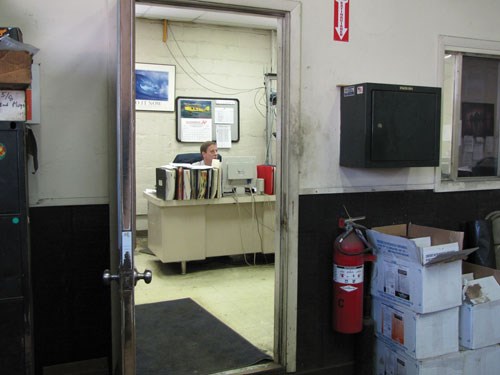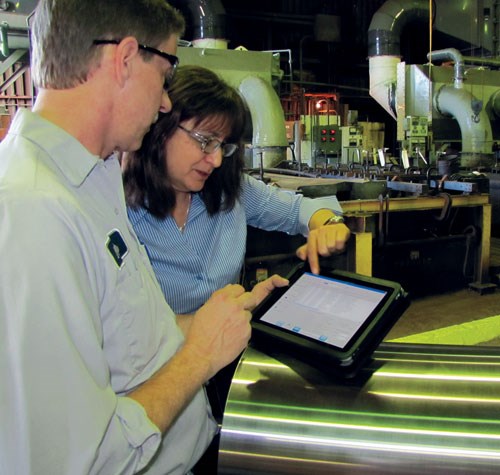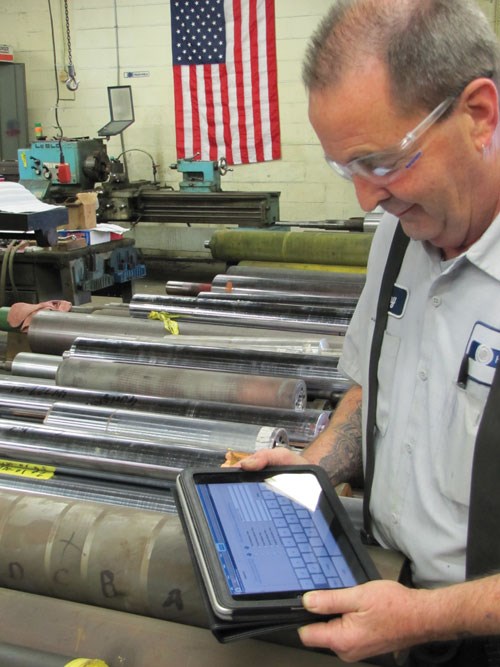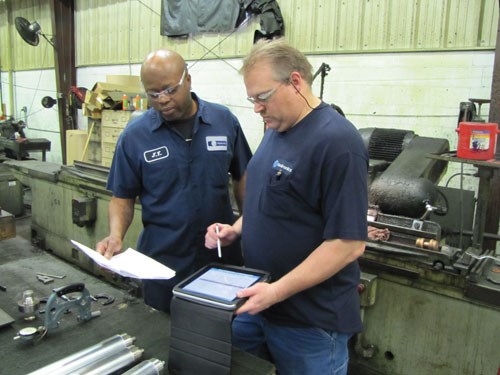Keeping supervisors on the shop floor sounds simple enough, but in many companies, this seemingly obvious need is often overlooked. For Cincinnati, Ohio-based Hadronics, it took one employee’s vision, the cooperation of the shopfloor staff and four iPads to make it happen.
Many factors contribute to keeping supervisors away from the shop floor. This was true for Hadronics, a 40-person shop that makes rollers and cylinders for the offset printing market. For example, because paperwork, such as the job travelers, was not moving with parts, machinery supervisor Harry Taylor was constantly leaving his shopfloor post to look for the missing parts or papers. Likewise, grinding and finishing department supervisor John Seiwert would take it upon himself to hunt down parts he was expecting but knew to be held up in another department. He says he did this to minimize the “heat” he caught when things didn’t ship on time. Moreover, plating supervisor Phil Robinson would have to go to the office at the other end of the building to add more process steps to the job traveler when a part was found to have a small defect. Going to the office was especially problematic because the shop floor is not visible behind the office’s wall and closed door. If there was an issue with either a part or machine, employees would have to leave the floor to find their supervisor.
Using E2 shop control software from Shoptech Industrial Software (Glastonbury, Connecticut) enables the shop to track where a part is at any given time, what machining processes need to be completed and where the part should go next, among other production data. Tina Lopreato, now vice president of operations, is familiar with the software because she used it during her 19 years in the company’s accounting department. One function of the software is its ability to generate reports based on the information the shopfloor supervisors entered from their office. Working closely with the reports, Ms. Lopreato could tell when there was a discrepancy between how long a job should take and the actual time it took to complete. She realized that productivity suffered when supervisors left the shop floor to enter and check information on their desktop computers. She also realized that every supervisor needed direct access to the software on the shop floor in order to make good decisions during the manufacturing process. The company needed to find some way to bridge this information gap.
Ms. Lopreato informed Hadronics president Michael Green that she was going to find a way to get production data to the supervisors on the shop floor so they could make better on-the-spot decisions, and he approved. Ms. Lopreato considered mobile handheld devices, but these had limitations. Mainly, the screen was too small. Also, if the supervisors started to use their smart phones for work purposes, then the company would become responsible for the supervisors’ monthly phone bills.
In search of a better solution, Ms. Lopreato enlisted the help of Kon Belieu, an IT technician from sCs Technologies, a local computer hardware and network service provider. After discussing the company’s software access needs, Ms. Lopreato asked Mr. Belieu if an iPad could be adapted for a mobile application. He said he didn’t see why it wouldn’t work. Ms. Lopreato purchased an iPad and asked Mr. Belieu to set it up for shopfloor use. Within 45 minutes, he attached the entire E2 workstation to the tablet device.
Using the iPad on the shop floor has brought a new level of communication and interaction to the company. Supervisors can access pertinent information and make changes on the spot. As a result, the company has increased quality, reduced rework by at least 25 percent, increased on-time delivery by 33 percent and cut lead times in half.
All Under One Roof
Hadronics has its roots in the engraving business. Ohio Valley Graphics was founded in 1970
after being acquired from Intaglio. The business was changed to concentrate on the wet offset business in the mid 80s, and Hadronics was formed. Over the years, the company has had to make careful decisions to adapt to changes in the printing industry. Following these trends and expanding process offerings has been key to its success.
From a layman’s perspective, making cylindrical rollers doesn’t sound difficult, but the technology behind the rollers is more complicated than it appears. Offset printing involves taking a sampling of ink and milling it down through a series of rollers into a film. This occurs while moving a film of water down to an almost-vapor thickness, which enables the ink to cover the plate and then transfer to a printing plate. The printing plate places a dot in the same spot each time the cylinder rotates around to the paper. “Hadronics can tighten the tolerance of the rollers, which gives customers the ability to increase print quality,” says Jeffrey McCarty, vice president of sales and marketing.
Maintaining a competitive advantage requires providing customers with superior quality at a superior cost, Mr. Green says. Downtime is critical for customers, who might be losing between $500 and $700 an hour when a printing press is being repaired. Increased roller lifecycles translate to less frequent press repairs. Likewise, speedy deliveries ensure access to fresh rollers when they are needed. This makes it necessary for the company to produce high-quality rollers and cylinders and to deliver them on time. Effective communication on the shop floor and throughout the building enables supervisors to plan lead time and give correct shipping dates. “The quality of our product is part of a total process. Managing the total process takes communication,” Mr. Green says.
Precise communication is paramount because the rollers don’t follow a straightforward path through the shop floor. At any given time, a roller can be machined, plated, ground or thermal-sprayed. Finishes include chrome, nylon, copper and chrome plating. “Very few people have all these processes under one roof because of the complexity it creates,” Mr. Green says. For example, it is common for the company to have a repeating order for a roller with a copper finish. However, the customer could suddenly change its mind and want a nylon roller. Being able to change processes on the fly without involving outside vendors has helped the company maintain its competitive position in the roller manufacturing field.
Another reason why many OEMs choose to work with Hadronics is because the company can provide its proprietary Hadron 2 plated-chrome finishes, which last longer and improve print quality. This highly controlled process involves multiple plating types and is the most complex process the company offers. “It’s a sandwich of corrosion barriers made from noble metals to resist acidity found in environmentally friendly offset printing trade,” Mr. McCarty says.
There are four basic processes for manufacturing rollers and cylinders: machining, plating, grinding and thermal spraying. These steps are obvious on Hadronics’ shop floor, which has been broken into distinct departments. All the departments occupy separate, side-by-side bays, connected by a center aisle on Hadronic’s 25,000-square-foot production floor. Parts take various paths—from one department to the next, and back again—depending on their specific manufacturing needs.
While this setup makes sense process-wise, from a communication standpoint, this division often caused a complete breakdown. Before using iPads, supervisors would go to the center aisle of the shop to gather information from other supervisors. To hasten this process, the supervisors would commonly yell down the aisle to one another. Of course, things were misheard or not heard at all. It was hard to relay the correct information to each department at the exact time it was needed. When a supervisor wasn’t standing directly in the hallway, other supervisors would have to leave their respective departments and walk to other departments to deliver updates.
The company’s communication issues came to a head in August 2010. In the weeks leading up to this crisis, work in process was going up, and shipments were going down. “A lot of work was underway, but nothing was getting done,” Mr. Green says. According to Ms. Lopreato, there seemed to be no workable plan, execution or control for moving parts through their various processes. “We were stuck in a cycle of nothing,” she says. Drastic action clearly needed to be taken.
Ms. Lopreato decided to call everyone in for an unusual Saturday session to identify the problem and work together on a solution. During this session, they discovered that the biggest underlying problem was that without full access to process information at their fingertips, supervisors had no way to communicate up-to-date information throughout the shop floor. Ms. Lopreato knew that this lack of information was not from missing shopfloor data. The shopfloor control software was working just fine, but it did contribute to keeping the supervisors off the floor. She realized that something else was missing. Essentially, the company needed to find a device that would get the data and the supervisors out on the shop floor at the same time.
Using the Technology at Hand
Ms. Lopreato never questioned the company’s shopfloor control software. It always performed well with the information the supervisors entered. Hadronics had implemented Shoptech’s E2 software in the summer of 1994. At the time, Mr. Green says the company appreciated the system’s customization and support capabilities. Since Hadronics does something new every day, it needed software that could handle making a variety of parts in small quantities.
According to Ms. Lopreato, the shopfloor control software did a good job of monitoring the company’s productivity. Unfortunately, it also exposed that the company was running at only 50- to 60-percent efficiency. The software revealed that many parts needed significant rework before shipping, an indicator that quality issues were slipping through the cracks. Ms. Lopreato saw these unsatisfactory numbers in the reports she reviewed in accounting. With this knowledge, she took a hands-on approach to finding a solution that would give the supervisors the information they needed to be more efficient.
Initial attempts to get the information to the right place at the right time didn’t work. For example, to increase communication on the shop floor, Ms. Lopreato implemented a flag procedure. In theory, this would be a more effective way to alert the supervisors if a machine wasn’t working properly or if an employee needed assistance. However, it did not remedy the fact that the supervisors still couldn’t see the raised flags on the shop floor from their office. Also, Ms. Lopreato says that employees became reluctant to raise the flag when something went wrong because they didn’t want it to reflect poorly on their performance. Lack of visibility and lack of cooperation made the flag system fail.
With late totals increasing, the company decided that something needed to be done to ensure on-time delivery. During the Saturday session, the supervisors identified that they were out of touch with what was happening on the shop floor. Jobs were being moved to other departments without being approved, and paperwork and parts tended to split the floor. “We soon realized that we’ve just got to keep the guys out on the floor,” Ms. Lopreato says.
The key to making this happen hinged on the supervisors’ ability to get needed information in and out of the shop control system. Like all such systems, E2 needs current and accurate data to provide a clear picture of what is occurring on the shop floor. To keep supervisors from spending a lot of time in front of computer screens in their offices, Ms. Lopreato needed to find a way to make that information portable.
Ms. Lopreato was aware that E2 had a mobile app, called Pocketview, for handheld devices such as a Blackberry. However, she wanted access to reports such as the job traveler or backlog summary without having to scroll through multiple screens. Also, downloading a copy of the app for everyone who needed it would be too expensive, Ms. Lopreato says. Though the thought process behind using the Pocketview app on the Blackberry was right, it turned out to be the wrong device for Hadronics.
Ms. Lopreato had been eyeing iPads since they first came out in April 2010. The iPad was Apple’s entry into the field of tablet computers. A tablet is a hybrid of a desktop personal computer and a smart phone. Unlike a regular laptop computer, which wouldn’t be convenient to carry around a shop floor, the tablet is extremely
lightweight and durable enough for a shopfloor environment. What appealed to Ms. Lopreato is the iPad’s extreme computing power and portability. Another thing that caught her attention was the ability to add and remove specific applications by administration. This was important for the workforce because it allowed blocking the Internet and gaming applications. Paired with an easy-to-read, 9.7-inch screen, the iPad became a natural choice to solve Hadronics’ portable software issue.
Ms. Lopreato admits to being nervous about introducing the iPad on the shop floor. “You deal with resistance to change from long-term employees,” she says. Despite her hesitation, the first iPad was introduced to the floor on the Monday following the company’s Saturday session. “This is going to work,” she told the supervisors. Luckily for Ms. Lopreato, it did. Mr. Seiwert received the first iPad, and according to Ms. Lopreato, he “flew” using it. Two weeks later, the company bought two more iPads to keep Mr. Robinson and Mr. Taylor on the floor. In January, the company won a fourth iPad through Shoptech’s Success Story contest and gave it to Ralph Demmel, the quality control supervisor.
By providing access to the full functionality of the shopfloor control system, the iPad has changed the entire shopfloor atmosphere. “Supervisors can make adjustments right on the shop floor. By not traveling back and forth, they are actually allowed to manage the cell,” Ms. Lopreato says.
Employees can “stay with the beat” instead of waiting around for supervisors to find out information from their office, she says. Right away, productivity and quality benefits started to show up. In fact, Ms. Lopreato says, the iPads contributed to a great September 2010 rebound. “It was the best fourth quarter we’ve ever had in terms of profitability and efficiency,” she says.
Holding New Standards of Productivity
In addition to improving communication among departments, having complete access to real-time information has benefitted each department individually. For instance, in the machining department, Mr. Taylor can review a part using job travelers, which improves inspection. He can then okay it and move it to the next step in the process. Using labor reporting, he can look up an order and router right there with an employee. He can identify a problem and make corrections and adjust the schedule on the spot. In the grinding and polishing department, Mr. Seiwert can use the production/backlog summary to review the shipment schedule. Instead of hunting down parts in other departments, he can keep working in his own department because he knows when to expect certain parts. Finally, in the plating department, Mr. Robinson can use the process summary to add new steps to the process if a quality issue should arise.
While the iPad has helped track inventory and take away the guesswork of where parts are, it doesn’t take away verbal communication completely. “As soon as we know we have a problem, we can tell other supervisors about it. They can adjust their schedules accordingly,” Mr. Robinson says. Current, traceable information enables efficient communication. For instance, Mr. Robinson says, “We may need an operator to stay longer to finish a job, but we can plan for this now.” Before, employees were notified at the last minute that they would be staying longer to finish a project. By knowing how much more work needs to be done, the supervisors can also use that information to decide exactly how many employees must stay later.
A surprising benefit of the iPad adoption is that it has helped Hadronics increase accountability. According to Mr. Green, some of the supervisors were stepping back because one supervisor was planning and executing work for the entire floor. It is not one person’s responsibility to make sure the plan and execution all happens, he says. With the iPad, each supervisor has become responsible for his own section, and they are more involved in the day-to-day operations. “It’s nice to see the supervisors work as a team,” Mr. Green says. The iPads enable the supervisors to make sure their floor is moving, and they can respond right away to all customer requests. Now, there is no reason not to know a part’s location and status in the process. According to Mr. Green, “Using the iPad has helped us to gain better cost control. It helps us ensure that we’ve dotted our I’s and crossed our T’s.”
The iPad was quickly recognized to be key to the company’s survival. “Growth requires you to go into areas you aren’t accustomed to,” Mr. Green says. Though there may have been a little resistance at first, the supervisors see the benefits of having the iPads. They now have a more visible presence on the shop floor. “I’m in the trenches with the troops,” Mr. Robinson says. “It is the handiest tool I have in my department,” Mr. Taylor adds. “It has helped us cut lead times. Late jobs used to be measured in days. Now, jobs are in and out in 10 days or less,” he says.
Mobility Strengthens Diversity
The printing industry is a mature industry, so Hadronics is interested in diversifying its product offerings to include other, similar fits. Mr. Green believes that the iPad will help the company gain market share in other industries.
“We need increased awareness in the marketplace, whether through e-news or other electronic media,” Ms. Lopreato says. One of her ideas was to equip their network of independent sales representatives with iPads and send them in search of similar product fits for the company to manufacture. The theory is that the iPad will help expand the communication improvements already realized on the shop floor, thereby helping the company diversify. The sales reps will use the iPads in essentially the same way that the shopfloor supervisors do—benefitting from its portability. It also gives the reps the ability to manage, communicate and view accounts in their territories in real-time, so overall service is improved.
“The iPads have been the best small investment for us in terms of opening communication,” Ms. Lopreato says “It’s all about having access to the information you need to make good, on-the-spot decisions.”
















.png;maxWidth=300;quality=90)
















